As you have probably already read through various internet sources – a ski mountaineering legend Stephane Brosse died yesterday (June 17, 2012) during a fast mission traverse of the entire Mont Blanc massive. He was accompanied by Kilian Jornet.
I don’t want to discuss details of the accident here, there is plenty of that elsewhere. All I want to do is to introduce him to people that started participating in or following rando racing after he retired from the sport. And pay a small tribute to him.
Stephane had a massive influence on the racing community along with his teams race partner Pierre Gignoux (the maker of the now famous carbon boots). They were fast, hungry, and brought so much innovation to ski mountaineering on many levels.
Here is a beautiful example of that – arguably the most fluent skimo transition ever made – while racing Utah’s Powder Keg in 2005:
Stephane won everything there is to win in skimo racing – World Champs, Pierra Mentas, the old classics (Mezzalama, Patrouille) and too many others to mention.
However, I will remember Stephane as the guy that climbed from Chamonix to top of Mt Blanc and skied back in only 5h 15min! He did this with Pierre Gignoux. (Wikipedia states they did it in 2007 but I think it was earlier.)
Fortunately, these days, the skimo world has as influential person as Stephane was, and I don’t think it was any coincidence they became ski partners. But it is very sad that “the passing of the crown” to Kilian had to happen under such tragic circumstances.
No one is invincible, and nothing is for granted. But that is precisely what makes life worth living. Because it applies both to life as being physically alive and healthy as well as to making us reach for our dreams – we can’t try to fulfill them just at our wish, and it is not granted we will even touch them.
My best wishes to Stephane’s family and friends.
People (Interviews)
Game Changers 3-article series: Interesting ski tourers answer "What is the one piece of gear that changed or influenced your ski adventures?"
I like to learn from people and about people because we are all unique characters. With some we have lots in common, with others only few things. But there is always something to learn.
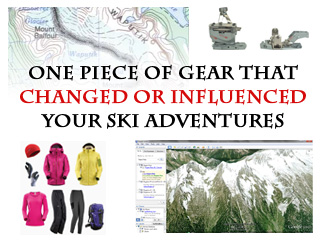 So I had an idea – let’s ask couple of interesting people 3 simple questions and see what comes out of it.
So I had an idea – let’s ask couple of interesting people 3 simple questions and see what comes out of it.
Since answers came in longer and deeper than expected I decided to spread them over three articles than jam everything together.
» To read answers, from the same people, to the 2nd question of the Game Changers series see – The person that influenced or changed your ski adventures.
Who is answering?
I reached out to couple of people that would represent the ski touring pool in every aspect – from exploring, adventurous skiing, to rando ski mountaineering racing:
Greg Hill – the 2 Million Man trail breaking machine, Dynafit Stoke ski features his name
(http://www.greghill.ca)
Melanie Bernier – 5th at World Ski Mountaineering Champs 2011, triple Canadian Skimo Champ, also very successful MTB rider
(http://inthetrails.blogspot.ca)
John Baldwin – Canadian West Coast ski mountaineering explorer and author of “Exploring the Coast Mountains on Skis”
(http://www.johnbaldwin.ca)
Christina Lusti – 2006 alpine Olympic skier metamorphosed into a backcountry skier and ACMG Assistant Ski Guide
(http://christinalusti.wordpress.com)
Stano Faban – this is me. I wanted 5 people to answer these and since I couldn’t get hold of Andrew McLean I humbly decided to take his place. Hopefully, I can fill in his answers later.
1st question: What is the one piece of gear that changed or influenced your ski adventures (whether that be touring or racing)?
Before you dive in, I want ask you to share the piece of gear that changed YOUR ski adventures. You can do so via comments section at the end of this article. It is always interesting to see what influences others.
Greg Hill says:
Google Earth changed the way I approach adventures! It increased the amount of terrain I could explore from home, which expanded what I could do out in the mountains.
I remember the moment I started using Google Earth, in 2006, it was getting information for the Bugs Rogers traverse [Bugaboos to Rogers Pass]. We were planning on doing some variations from thee normal route and we spotted this 4500 foot avalanche path into the Duncan creek. Weeks later when we rolled into the line it looked exactly like on Google Earth, and we skied it top to bottom completely relaxed, knowing the line was cliff free to the valley bottom.
Up until that moment all our information came from maps – vague 100 foot contours hinting at the terrain that was out there. Huge cliffs could hide in the middle of lines, a line pondered and penciled in at home could turn out to be un-skiable.
It was harder to truly daydream a line, you could see the potential but there was always a huge amount of unknown. With Google Earth you can view lines from all angles, tilt them and look down them. Check out approach, spot hazards from home and then go out with so much more information.
You can spot a line from 100 km away, go home and view it close up, mark it “Cool Peak”. Dream about it for a few months and then go and ski it, feeling like you have already been there. It’s unbelievable!
Melanie Bernier says:
Ski touring bindings.
Growing up, there was a cross-country trail just across the street from my parent’s house. Getting lost in the forest with our cross-country skis was what we would do after school.
At 8, I put the free heal equipment aside when I discovered a new passion for downhill skiing. After learning the skills and racing moguls for years, I would have never thought this amazing sport could get any better until the day I moved to the West Coast and discovered touring bindings.
The purchase of my first pair changed my perspective forever. It totally made sense tying in the cross-country skiing roots, which were still present in my heart and the ever-growing passion of downhill skiing. It offered not only a way to fulfill my desire for exploring beyond the boundaries but also the love for carving turns in the white fluffy stuff.
It allows for freedom of the destination, the length of the journey and the type experience. In a rando ski mountaineering racing perspective, the type of binding and their evolving technology allows now not only to discover new terrain but also cover the distance with speed and confidence.
As simple as it sounds, the piece of equipment that charged my perspective in ski touring and racing is the piece that rests between my boots and my ski.
John Baldwin says:
Stano, that’s a tough question. I’ve been skiing for 40 years and have used a lot of different equipment over the years.
I don’t feel that old but I do remember leather downhill ski boots, jackets that had cotton in them before there was Gore-tex, clip on skins, and sat phones and GPS hadn’t been invented. Most of the gear we use has generally gotten way better and we have some pretty amazing gear nowadays. As a package all of it has influenced my ski adventures.
To single out one piece of gear is hard! But if I had to pick one thing I think it would be maps.
I started backcountry skiing in the 1970s. Back then there was no Coquihalla Highway (BC, Canada), no winter access to Duffey Lake (BC, Canada), and far fewer logging roads. There were areas that didn’t have 1:50,000 scale maps. Many of the detailed maps of the Coast Mountains were not completed until the mid 1970s.
I remember going on a trip to the Manatee Range in 1979. Hardly anyone had ever gone in there skiing. Access was from logging roads that were still under construction. What really influenced my ski adventures was the map that we had. It was a new 1:50,000 scale map of the area.
Half of the map showed the Lillooet Icefield which is just north of the Manatee Range. I remember staring at the map. It showed huge glaciers and I was so curious to see what those large blue areas on the map looked like. In a way it was that map that got me started on going to all these wild incredible places in the Coast Mountains.
Christina Lusti says:
All of my amazing Arcteryx clothing!
I love spending as many days skiing as I can. . . So being suited with Arcteryx’s finest makes my days in the mountains comfortable.
Stano says:
As John pointed out, it is difficult to single out one piece of gear and I definitely agree with any of the choices above. But I wanted only one, so here is mine.
The game changers for me were a pair of Dynafit Classic bindings. I think it was in the winter of 1999/2000 when Peter Svatojansky (an upcoming top Euro skimo racer at the time) recommended that I switch from Silvretta to Dynafit even though I was not seriously racing skimo back then. To this day I am grateful my father spend the money to let me have a pair of quite light Dynastar skis mounted with the Classics.
These bindings have not only let me enjoy mountains more and feel less sore for next day’s triathlon workouts but they showed me that if you buy a quality product you never have to buy again. To this day I remount them from skis to skis. They are 12 seasons old and I never serviced them once!
Next question: Who is the one person that changed or influenced your ski adventures (whether that be touring or racing)?
To read answers to the 2nd question of the Game Changers series see – The person that influenced or changed your ski adventures.
» Signup for our newsletter (top right of this page) or follow us on Twitter and will let you know when any new article is up.
What piece of gear was your game changer?
Share what was The piece of gear that changed your ski adventures, be it backcountry or racing.
And thank you for enjoying the read!
Nina Silitch interview: Skimo racing mom gets the first ever ski mountaineering World Cup win for North America
On April 5th I congratulated Nina (via her blog) on a great racing season and asked whether she would consider an interview for Skintrack. A day later she replied: “I’d be happy to…”.
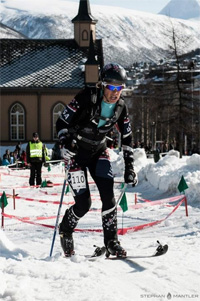
Fast forward nine days and on April 14th Nina Silitch became the first North American to win a ski mountaineering World Cup race! I mean, a North American won a skimo World Cup race! Wow, in all my “calculations” I couldn’t see this coming for at least another two-three years.
It is a great accomplishment and we obviously gonna talk about it. But we are also going to talk about more as Nina is a mom of two and lives now in Chamonix, France.
Q: You just won your first World Cup race. Was it a beautiful surprise or you felt throughout the season it was reachable?
For me the sprint is something I really love. Yes it was a beautiful surprise, but I did believe that I was capable of a podium in the World Cup Sprint.
Q: Can you describe the skimo sprint racing format.
The Sprint format encompasses all aspects of ski mountaineering into a very short race. It was started to help bring more spectators to the sport as when it is in the mountains it is harder for people to watch.
There is a goal for skimo to be an Olympic sport one day, and the sprint is an event that can draw a crowd. It is the same format as the World Cup cross country sprints that have now become a newer discipline.
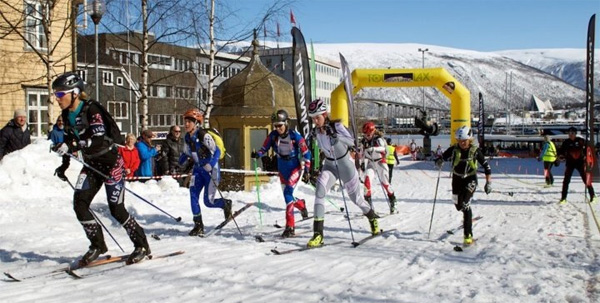
The start is on skis with skins going straight to a series of kick turns, followed by a transition to a boot-pack (skis on the pack) then another skinning section, followed by a descent that encompasses both alpine gates, on and off piste and also skating.
Athletes must not only be quick on their feet but also very efficient in their transitions. It allows them to specialize in something, as a sprinter will train differently than a distance athlete.
Q: Is it your favorite skimo racing discipline? Are you naturally a good sprinter or you started to focus on this event only recently?
It’s funny because I love the sprint and all the concentration and focus it involves, but I also love longer races of 4-8 hrs.
I realized I had talent in the Sprint race when they first started and I definitely tried to hone my skills a bit. I always have started a little too fast in races but this is actually good for sprints.
Q: How many World Cup skimo racing seasons do you now have under your belt?
I did my first world cup in 2009 at the Valerette in Switzerland. I remember loosing a ski on a boot-pack and miraculously launching for it and catching it before it went 300 meters down a big slope.
I have consistently raced the World Cup circuit the last 3 seasons, with the last 2 seasons 2011, 2012 not missing one race. This year I placed 8th overall in the World Cup in a pool of very strong women, where the level grows and grows each year.
Q: Do you ski during summer (no snow months) as well or you rely on honing fitness through other activities?
I like the change of seasons and take a break from skiing in the summer. The earliest I would find snow would be end of October, though, one time I did ski in July just for fun when it snowed in Chamonix.
I enjoy trail running, road and mt biking, yoga and pilates. I do some roller skiing but not until the autumn.
Q: What are your three favorite skimo races? And why?
The Pierra Menta 4 day stage race – it is truly the heart of ski mountaineering. It is the hardest race I think as each day you have to get up and do it again. But the challenge, the camaraderie and the energy from the crowds keep me going.
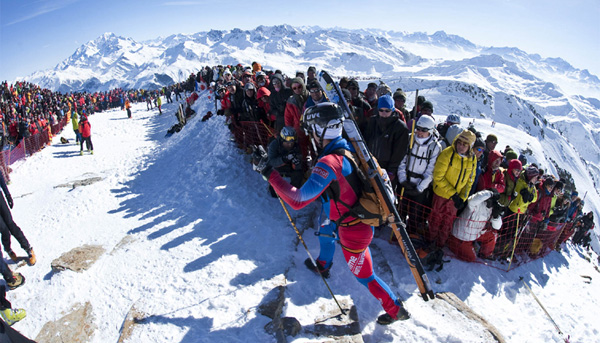
French national Sprint race – it was held in my home town of Chamonix. It was an amazing feeling to be racing in my own town, with friends and locals cheering, my husband and boys on the side lines too under the lights at night. I took 2nd here behind world champion L. Roux.
Q: Your background is in downhill and cross-country skiing. Why ski mountaineering now?
I grew up in New England, learning to ski in Vermont and Maine. I was an alpine skier when I was younger and really did not like it when my parents dragged me out cross-country skiing. I found it boring.
I did a couple years of alpine racing at age 13-14 at Carrabasset Valley Ski Academy in Maine, however, after ACL knee injury when I was 14 I decided to try my hand at Nordic racing. I was inspired by a teacher and coach, also a former US cross country team member.
It turned out I loved it and continued skiing in college for a few years, though, not on the high level team. I was not so into the high competitiveness in skiing and also got quite involved in rock and ice climbing as well as telemark skiing.
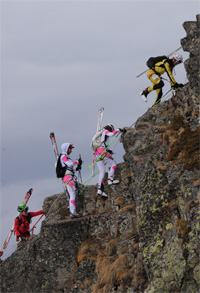
I did my first ski mountaineering uphill race in 2005 after my first son was born in 2004. I loved the challenge of getting up the mountain and the fun ambience after the race with a nice pasta meal.
Eventually I learned that there were more than just uphill races. It really was not until we moved back to Chamonix after living in Switzerland that I really discovered the sport.
The first race I did my youngest was about 10 months old, I was still breast feeding. But I managed to go do the race and get back for the evening feed.
I grew to love all that skimo encompasses: the challenge of the climbs, the thrill of the descents, the technical aspects of the climbing. It combined endurance, skill, power and the beauty of mountains.
Q: There is quite a difference between the number of men and women athletes taking part in ski mountaineering racing. Is this only at the faster level or is it similar at the local races throughout Europe?
I think like most endurance sports – trail running or mt. biking – there are less women in theses sports. There are less women in general but I am pleased to see the pool of women growing in the sport.
I encourage women to get out and try it, not by shy. Start with an uphill, like I did.
Q: Why do you think more women don’t race? Because I don’t think it is a “manly sport” as all the girls that are racing are great looking. 😉
In Europe it is not a new sport, but rooted in the Alps. Yet, still the pool of women is much smaller than men.
In North America it is a newer sport but it’s great to see it growing like mt biking grew in the 90’s.
I think that sometimes the technical aspects of the sport can be intimidating but also the price of the equipment is an issue.
Q: Do you have any advice for the skimo community (organizers, novices, ski partners…) that could help to raise this number?
I am all for empowering women in sport, especially this sport.
Holding Women specific ski-mo clinics, camps or workshops is a great way to start. Races can give ½ price entries to women or even have uphill climbs that have free entries for women.
Offer community slide shows or presentations by athletes who race at a higher level, and include women to speak at these events.
Q: You obviously spend lots of time training but you have two young sons. How do you balance it?
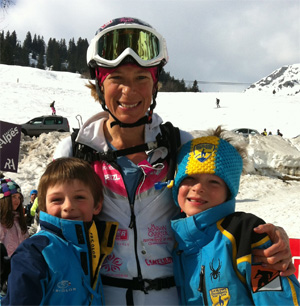
In the winter I actually train less than I would in the fall when I am really doing more volume training.
During competition season this year the volume is lower as more time is spent racing and recovering. As an “older” athlete I have learned that I need more recovery time and the importance of listening to what I need.
With that said there are certain times in the competition season where the volume can be up as high as 20hrs, but mostly 12-15hrs not including racing.
This year, I raced 20 races – 7 world cups, 3 grande courses, 3 national championships as well as some smaller local races.
My boys do join me on hikes, bike rides and skis. I try to include them as much as possible in my training, and sometimes I have no choice so I make it work. My older son is passionate about skiing. This year he tried skinning with Nordic skis and a narrow pair of skins.
Q: You live in Chamonix, a town with rich history of steepest skiing. Is that the reason?
We moved to Chamonix about 10 years ago when my husband completed his international mountain guides certification UIAGM. He was one of the first Americans to hold this certification. For a mountain guide, Chamonix is really the ideal place to work, as you can come home at night.
Q: Dreams for the future?
I have a dream of continuing to live a balanced lifestyle that integrates sports in the mountains, good health and wellness combined with family and friends.
I hope the sport of ski mountaineering continues to grow. I am proud to be a part of that growth and would like to see more women in the sport, more athletes in general as well as one day it become an Olympic sport.
I helped start the ski mountaineering club in Chamonix 3 years ago with only 5 members. This year I have taken over the role of the President and our membership has grown to almost 70 members. This is a great step in the right direction.
Q: Any advice for the racing folks back on the NA continent?
Keep helping the sport grow, especially with the younger athletes. It is with the youth that we can really start to develop the skimo programs. Offer camps and mentorship programs in schools and ski clubs/partnerships with ski shops.
Keep bringing on more racers that can excel against the Europeans who have been doing it for so long.
Thank you
Thank you Nina for sharing your experiences, dreams and inspiration with us.
» Nina Silitch blog
Transcript from a live Twitter interview with Reiner Thoni (North American ski mountaineering champion)
The following is a transcript from a live interview we did (@Skintrack) with Reiner Thoni (@ReinerThoni) on February 20, 2012 using Twitter. It was a great 2h session with about 20 people listening in.
Couple of questions came also from our audience (Skintrack’s Twitter followers) by which they qualified for a draw to win two light avalanche shovels. The winners were announced a day later, see at the very bottom of this page.
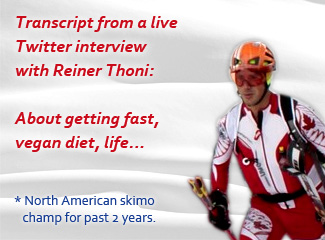 How to read the interview:
How to read the interview:
1. Text in bold are questions either from Skintrack or posted by us that people wanted us to ask.
2. Reiner’s answers are all in normal text, sometimes preceded with @ReinerThoni (his Twitter handle).
3. Italic text are our comments or additions to Reiner’s answers. They are sometimes preceded with @Skintrack (our Twitter handle).
Background questions
Q: You are 27, when did you start backcountry skiing?
I have early childhood memories of touring into huts. However it wasn’t until after adolescents that it became a regular part of my life.
Q: At what age did you start ski mountaineering racing?
At the age of 21 Mr. Ian Gale introduced me to the inaugural Sunshine 5000. Life hasn’t been the same since… 😉
Mr. Ian Gale is @goldenskimo – http://goldenskimo.wordpress.com
Q: What were your first racing experiences like? What did you think of the sport?
Moving through the mountains fast was exhilarating it was the fuel. @greghill2mil handed me race skis + inspiration that was the spark.
Greg Hill is @greghill2mil – http://www.greghill.ca
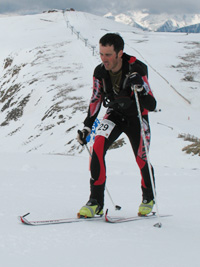
Growing up in Jasper National park we didn’t have many organized sports, just racing each other through the bush and building forts. 🙂
Q: Which race in last 2-3 years challenged you the most or who? And why?
Depends on the day but Brendon French (former American skimo champion) has put on the most hurt. @slukenelson and Andrew McNab are also guilty of that. The Pierra Menta in 2011.
Luke Nelson (American skimo team member) is @slukenelson.
Q: You greatly listen to your body and mind. Do you follow any training plans?
I let my body and mind dictate my plan. I have written things down in the past but no more. Learning to eliminate unnecessary stress is key!
@Skintrack: I like that a lot 🙂
About Reiner’s diet
Q: You are a lifelong vegan, looks like it suits you well. Is your family completely vegan too?
My dad and I are the diehards although we all like to eat a healthy balanced diet.
Q: What is your usual pre-race breakfast? I saw you eat a bowl of quinoa for breakfast when racing at World Champs in Italy last year.
Oatmeal or Quinoa with some fruit, peanut butter and hemp or Chia seeds. mmmmm POWER FOOD 🙂
Oatmeal is my usual though.
Q: Reiner, until about a year ago you did not drink or ate anything during races. How did you do it?
In my mind I would normally go without food or water for 3 hours so why any different on race day. Ignorance is bliss.
Q: Do you bring any drink or food now?
I went full circle from nothing to salad dressing jars full of date goop to now a gel of natural honey with 300-500ml water + rock salt.
Q: Have you ever used any food or sport supplements? Whether for racing or just skiing?
Mother Nature seems to work in harmony. Isolating things causes problems. The extra money on organic food is a much better option.
Fresh varieties of local organic fruits, veggies, seeds, grains, nuts, mixed with creativity and love are the corner stones to a healthy diet.
Q: You seem to have a lower maximum and racing heart rate than most. Could this be due to your diet? Or do you have a theory?
@Skintrack: Don’t be mistaken if it seems like Reiner attended some seminar on vegan diet and mind control, he lives this way since a small boy.
I feel the rate is genetically determined, however, the quality of what you are pumping makes a big difference in how the engine preforms.
Questions from our Twitter followers
@slukenelson asks: Does Reiner’s homebrew gel concoction contain some type of doping agent? 🙂 (I think that’s his secret to success)
@ReinerThoni: Not sure if the Euros would approve but date goop and honey seems legal enough 😉
@Skintrack: I think it is the love with which he prepares the 300ml of H2O with honey before each race :))
@JeremyRietmann asks: How does race time correlate to gear weight? If you drop 20% in gear weight, what % faster you expect to go?
@ReinerThoni: I have done experiments with different gear on a controlled hill. I found over a 40 min climb losing 400 gram per foot saved about 50 sec.
Articulation of the boot plays a role as well as steepness but moving from 1kg boots to a 0.5 kg PG I would expect around 2% improvement..
@Skintrack: Jeremy, there likely is a difference between dropping 400g from 3kg vs from 1.5kg.
Reiner, I would agree on those 2%, which is 1min 12 sec over an hour of climbing.
@NiallGCanada asks: What training tips do you recommend for guys that live in a city (Calgary) and have limited access to the mountains?
@ReinerThoni: When the environment doesn’t invite you to play I think it’s important to be creative and find something to motivate you. Challenges work!
See how fast you can make it up that hill or to that post. Bringing a dog helps change the perspective they find pleasure in the darkest places.
@Skintrack: Niall, doesn’t have to be specific (gym, run). Try to find every week a great challenge, after some time you will have a library of sessions.
@AndrewJPinfold asks: To win the NorthAm champs what kind of VAM/hr were you doing on the climbs?
@Skintrack: It likely was around1100m/hr. Hard to compare to cycling though because of very varied terrain (and quality of tracks) in skimo races.
The best (@kilianj) did 3000m race on groom-ish runs (controlled environment) in 2h17m. About 1h50m was for going up, so 3000m in 1h50m :))
If you wonder what VAM/hr is, then it’s what skimo world calls “vertical speed”.
For full Wikipedia definition see http://en.wikipedia.org/wiki/Velocity_Ascended,_Metres_per_hour
Continuing after the readers’ questions
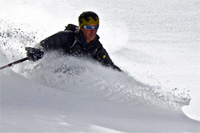
There isn’t much record keeping but I know of 2 other occasions that it was skied from top to bottom. We did a similar descent as the 1st.
For more info see my blog – http://theoutsideout.blogspot.com/2011/09/robson-skimountaineering.html
Q: You skied Robson on skimo racing Trab skis and Pierre Gignoux carbon racing boots. Did you question this light equipment choice at any point?
Originally, I was nervous but with a year of hard skiing on it I felt comfortable after double checking all the rivets and leavers.
Q: Back to racing questions: You (and I) recommend more people to try skimo racing. What good reasons can you provide?
It’s a gate way to moving light and fast in the mountains, inspiring you to train and learn the fastest possible way. Amazing people…
Q: You are a big competitor but friendly as hell 🙂 quite a happy guy no matter what. What is your philosophy that always keeps you smiling?
I try to keep things in perspective and not get caught up in small stuff. We are the creators of our thoughts and we have control over this.
Q: Besides bigger engines, what do you think North Americans are lacking to start placing in top 10 or top 20 at world level skimo races?
The major thing we lack is the support that the European nations get from both their communities and government. It’s like hockey over there!
@Skintrack: Well, we are building the community right now 🙂
Q: What mountain/sporting/athletic performance do you really dig? Or whom?
Tooshay 🙂
@Skintrack: Prince Albert steering the bobsleigh down the Salt Lake City track? :))
I dig what @kilianj is doing right now in both Ultra running and Skimo racing. Following his heart, I think that’s inspiration for us all.
Kilian Jornet (currently the fastest skimo racing athlete in the world) is @kilianj.
@DavidDornian asks: Is it productive to train transitions or is a little practice now and then enough?
You can even do it inside on cardboard if there isn’t any white stuff outside.
@Skintrack: At first, quantity helps to improve quality but later on occasional brushing should be
@Skintrack: I once read that “excellence is not a skill, but practicing one skill until becomes second nature is.”
Snow shovel winners
@Skintrack tweeted a day later:
Snow shovel winners from last night’s interview with @ReinerThoni are @JeremyRietmann and @AndrewJPinfold, will contact you for your shipping addresses.
Did you like the interview?
We got a great response on the interview from our Twitter followers.
What do you think? Should we do more of these? What questions you want us to ask in the future?
Live Twitter interview with Reiner Thoni at 7pm Sunday, Feb 19
Update (Feb 20):
Big thanks to everyone for following or participating in the interview with Reiner last night. A transcript of a shorter version from this session will be posted on Skintrack in couple of days.
Prize winners – the two guys that will get the light snow shovels for submitting a question are @JeremyRietmann and @AndrewJPinfold.
Listen in and learn with the fastest skimo man in North America.
+ Tweet us your questions and win a prize. See how to participate below.

When
On Twitter starting at 7pm PST on Sunday, Feb 19, 2012.
7pm Pacific Time => 8pm Mountain Time and 10pm Eastern Time.
Why you should definitely follow this
By following the tweet interview you will get some great tips and learn about Reiner as well.
Besides the fact that he is the fastest ski mountaineering racer in North America – won the Canadian and US Championships the last two years – he is a much more interesting character than that.
» Previous racing 101 with Reiner – Video ski mountaineering transitions.

- being fast in the mountains
- skimo racing
- food and diet since Reiner is a life-long vegan
- his interesting and sometimes amusing life style
- some of his adventurous mountain missions
How can you participate + win a prize
- Sign up to follow Skintrack on Twitter now. Already a follower? Then just read below.
Follow @Skintrack
- Tweet us (@skintrack) your questions before Sunday 6pm – hour before we start.
4 basic rules:
– send in your tweet (question) with @skintrack at the beginning
– each question must fit within one tweet which is actually no problem (140 characters long)
– answers will be maximum two tweets long, be creative and ask questions that can be answered in 280 characters 😉
– longer questions or those that require a longer response will be answered later on this page - Win a prize – by following @skintrack on Twitter and tweeting us your questions two people will win a light snow shovel that is suitable for fast mountain missions and even fits in tiny skimo racing backpacks – Ortovox Economic I snow shovel.
The winners will be chosen by Reiner and Skintrack based on the “most creative short and sweet question”.
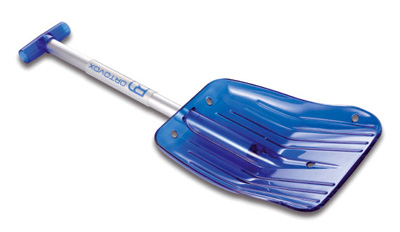
Less traditional interview: Greg Hill – the man behind
Greg Hill’s skiometer sometimes reaches values of national debts of all countries combined. In fact, he too raises his ceiling regularly to make sure his addiction is well and alive.
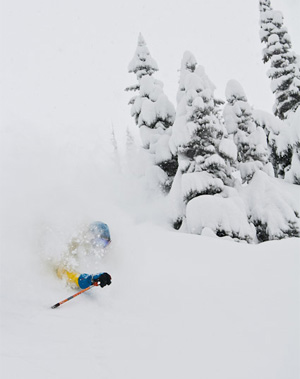
If you find some questions in this interview a bit “off” then that is OK because there has been too many same questions Greg had to answer before. (For more traditional answers see a clip from his TV interview below.)
Here goes the random shooting. Enjoy.
Q: How do you view life – a journey, a chance, responsibility, leave a mark…?
Life is about being happy, to simplify and be who you are. For me, happiness comes from challenging myself, being outdoors and having fun with my family and friends.
Q: Do you look back at things or events and wonder?
In a hundred years nothing I do will matter to anyone, so I can do what I want and be happy with that. Failure is fine, I prefer success but you have to fail to figure out how to succeed.
Q: In 2006-7, you attempted to ski 100 days of 10,000 feet days. You fell short. What was the result of that – learning, another journey, dissatisfied…?
It was a step in getting fast enough to try and ski 2 million. To accomplish my 2 mill I needed to be able to pull off lots of 10 thousand plus foot days. So I spent that season honing my endurance so I could do back to back big days and get used to the demands of such challenges.
I also learned about timing – I ended up running out of time that year and heading to England with my wife and daughter. If I had really wanted to I could have cancelled that trip and perhaps made it happen but I was happy with what I had done.
Q: What is your take on raising kids? Freedom, rules, values, education…?
I want my kids to grow up happy and confident in themselves, and to follow their passions. It does not have to be mine but I would really enjoy getting out and summiting some mountains with my kids one day.
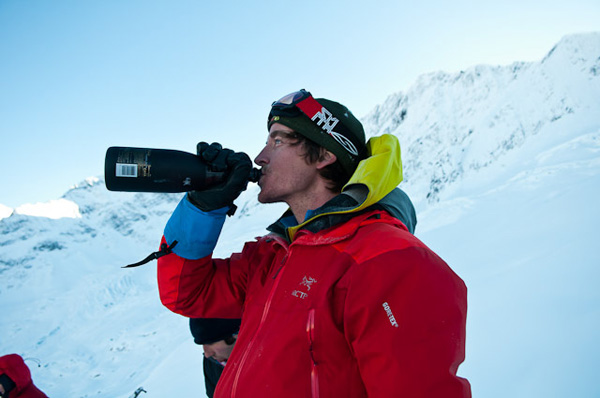
I really enjoyed my years in the ski mountaineering racing scene, but my main goal was always to explore around the races and ski mountaineer. So they were a great way to go to places I had never been to.
I am a competitive person and I enjoyed the game for awhile but I relied mostly on natural ability. Once I realized that I would need to train really hard to get fitter and that it would take away from my ski mountaineering adventures I pulled out.
So often I would be exploring the mountains around the race right up to the day and then race with a tired body – a psyched mind from what I had done but a tired body. So to further myself I would need to take those great adventures out and focus only on uphill speed with light skis. Which is great but not where my true passion lies.
Q: Do you have a favorite music style or a band? A favorite movie or a book?
Not really a musical guy, I enjoy music but I could drive the whole way to Vancouver and never put a song on. I enjoy reading and read a lot, all sorts.
Q: What did you do in 2011, the year after the 2 mill push?
Years ago, before I was a ski mountaineer I was a passionate rock climber, in 1999 I dislocated my shoulder and changed my path in life. But for over 11 years it had slowly gotten worse and needed some real help. Knowing that I would have no motivation for skiing after my year I organized it so that I could get surgery almost immediately after my feat. So I went under the knife.
Then, in early June I went back to Mt-Rainier, the first mountain I had attempted to climb when I was 18. So 18 years later I returned and skied off the summit, a 10 500 ft run on June 5th. Pretty unbelievable.
I also learned a new sport this summer – mountain biking. It was so great to start something fresh and progress. I bought a bad ass mountain bike and began shredding the mountains around Revelstoke. Having great mentors and fun trails made it really exciting.
And honestly, I toured about 5% of what I had in 2010.
Q: Your favorite booze?
Gin and Tonic.
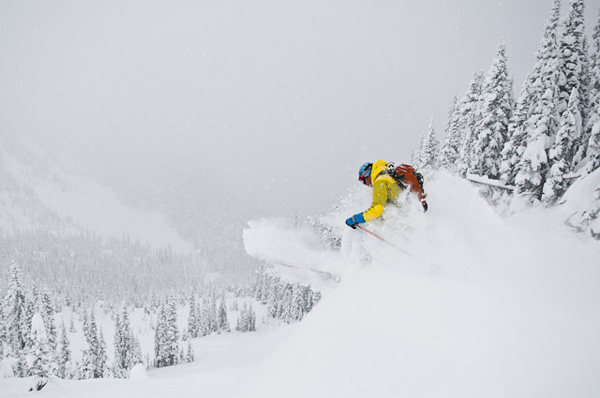
My desires are mainly about skiing nice lines in good snow. Any time I have gone higher the skiing has gotten pretty bad, a big exception to that is Mount Blanc. We managed to ski it in untracked powder conditions and it was amazing.
But I am interested in an 8000m line and what it does psychologically to people. The Himalayas must be amazing and should be a must visit on any ski mountaineers list.
Q: How much (how well) do you document your daily ski outings? Do you document the bigger ones more specially – those that had a bigger meaning for you?
I go through fits and bursts. For years I documented well, always writing the lines down on maps and recording the time and such. But then for 5 years I have run a blog which has been pretty well documented of all my great days.
When a day is boring and uneventful than I probably won’t write as much as a day where I summit a new mountain and shred a great line.
Q: Can you share your favorite 3 places/valleys/runs to ski?
I am not one to have favorites but obviously Revelstoke is my home and favourite ski place, there is so much available to ski around here. Whistler and the Coast Range have been my training grounds for years and I love the Spearhead. Then Las Lenas seemed pretty off the charts when I was there.
Q: What are your ski and mountain plans for years to come?
Lots of unskied lines and mountains await, I have a huge list of great mountains to climb and I hope to get to them all.
I would like to ski all the 3000m (10000 foot) mountains in the Selkirks. I have skied 30 of the 70 so I have lots waiting.
Greg’s TV interview from November 2010
Thanks Greg
Thank you Greg for letting us to peek inside your mind and sharing your thoughts.
To follow and get to know him even better visit his website GregHill.ca.
John Baldwin interview: passionate ski touring explorer dedicated to one, but huge, mountain range
Spring conditions, longer days and good friends make for amazing multi-day trips. And since we are in that time of the year here is an inspirational interview with one of the greatest Canadian adventurers. Enjoy!
Many people have big goals or great plans but somewhere along the way they get side-tracked and they steer away from their dreams, even though they were completely obsessed with them before.
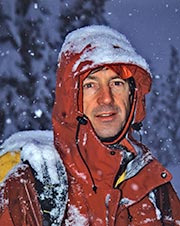
I don’t know John Baldwin well enough to categorize him within the two groups, however, I know John well enough to draw great amounts of inspiration either from him as a person, from his guide books or simply from hearing his name from other people.
John Baldwin is a ski touring explorer and a photographer that over the past 30 years pioneered the biggest traverses in the most remote areas that can still be reached by foot. Living in Vancouver, BC he dedicated himself to explore the Coast Mountains of western BC to great extent and detail.
One year ago John released a third edition of his guide book – Exploring the Coast Mountains on Skis – where he was finally able to complete the publication with trips over the full length of this almost 1500km heavily glaciated mountain range.
I and many other ski tourers can’t now even imagine to do a traverse on the west coast without referring to John’s book on a daily basis.
John Baldwin shares his adventurers and offers some advice
Q: You are dedicated to explore the Coast Mountains. Why this mountain range?
I grew up in Burnaby and Vancouver. I used to stare up at the mountains and wonder what was behind them. What I discovered was this incredible mountain wilderness that stretches for 1500km. And I’m continually drawn back!
Q: How do you pick your new destinations? Is there a master-plan and you just go down the list?

Sometimes you see a peak or a run or an area you’d like to check out or you get an idea for a route or ridge that might connect.
For local trips, I also get ideas from guidebooks (including mine!), friends and trip reports too.
And ski mountaineering depends a lot on weather, snow and avalanche conditions so I like to have a bunch of trip ideas on hand and then pick the one that suits the conditions best.
Many trips are best at certain times of the year and that definitely comes into it as well.
Q: To travel to new places, through new mountains, requires long trips. What time of the year do you do your traverses? How long do they usually take?
Most of my long trips to remote icefields and high glaciated summits are in May. I love winter for full on snow but spring is definitely best for longer trips to high alpine areas.
Weather and avalanche conditions are generally better. Long spring trips are anywhere from 2-4 weeks but most are about 3 weeks.
Q: The best thing about your travels is that you are sharing them with others through your guide books. Do you feel a certain duty to share information about new places for others’ enjoyment, or is it just a natural progression because you keep detailed records about your trips anyways?
I’m constantly blown away by how beautiful the Coast Mountains are and by the incredible opportunities we have to ski in such an amazing place.
I want to share that with other people and turn them onto what we have here, either through pictures or through trips they might do.
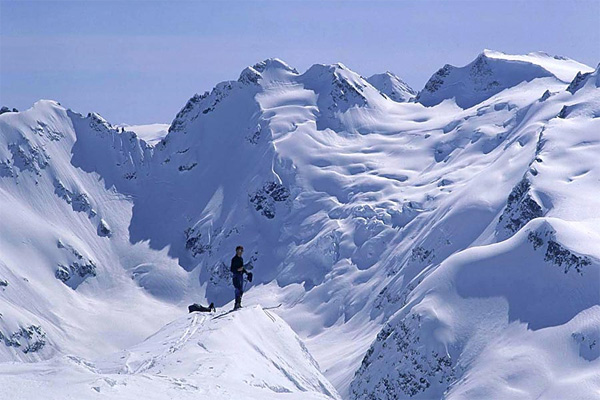
My guidebook covers the entire Coast Mountains, which stretch north from Vancouver for 1500km to Skagway, Alaska.
Two thirds of the book focuses on trips in the south-west corner of British Columbia, the rest covers the more remote areas all the way up the coast.
Q: You have telemark skied all your traverses. Now, you are also starting to use light alpine touring gear for backcountry skiing. Which one do you find more suitable for long traverses and why? Which things should one consider before he chooses the right setup if he wants to start doing long traverses?
I don’t have strong preferences on recommending gear. I have used all sorts of gear over the years. I started on xc skis in 1972. I used AT gear in the mid 70s, then lots of different types of gradually improving tele gear over the years.
Last year I started using Dynafit bindings. I’ve seen people do everything from gentle tours to steep descents on gear ranging from tele bindings to Dynafits, Fritchies with big stiff boots and even split boards.
I think the reason there is a lot of good gear out there is because of all these different influences. There is a lot of crossover that leads to new ideas and better gear.
Q: What do you use for navigation on traverses in new areas?
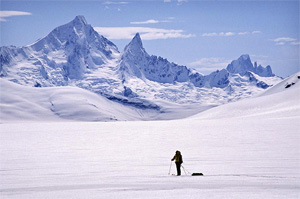
I only use a GPS in bad weather, when they can be really helpful – but don’t forget they don’t help you see crevasses and other hazards!
Q: Were there always topo maps you could get your hands on or did you even do trips where you basically were drawing the map?
The 1:50,000 maps were all finished in the 1970s and that is what I have used for all my trips. They are generally very good, but it’s still a big jump to what the terrain actually looks like. For example, rock bands and heavily crevassed areas don’t show up.
For some trips I would try and check government air photos as well. Now there is Google Earth, which is generally very helpful (though in some areas with low res its hard to see crevasses).
Q: I noticed you don’t use watches when backcountry skiing. Do you use them on multi-day trips? Do you use an altimeter?
It’s great to know when it’s lunchtime and for a long day trip it’s helpful to set a turn around time. But I don’t find knowing the time to be that important when you are on a longer trip (though my friends usually have a watch!).
You develop a sense of the time and you can always look at the sun. I always mean to bring a watch but usually forget.
Altimeter watches are very useful for watching pressure changes in the weather. Occasionally, they come in handy for navigating too.
Q: Do you carry a satellite phone or something else for communication with the world while on a ski traverse?
Yes, but we only use them for emergency purposes. Before there were sat phones we would carry and ELT (Emergency Locator Transmitter) on some long trips.
Q: Do you use food caches on your traverses or do you carry everything yourself from the beginning?
Both, depending on the trip.

I went to UBC (University of British Columbia) and learned a lot in the Varsity Outdoor Club. There were no courses of any kind back then so the club would organize lectures and ski schools etc.
More experienced members or other people like Peter Schaerer or Frank Baumann would come and give lectures on avalanches, first aid, backcountry skiing and all sorts of topics. The rest I learnt from experience, and trial and error with my friends.
In terms of exploring – I think I learnt that from my father. He wasn’t a mountaineer but he always had an interest and curiosity in the world and life. To me exploring is not really about goals, it’s sort of like following the scent of something to see what it turns out to be.
Q: Where is your next trip planned?
The Coast Mountains of course! My next long trip is in May to the Lillooet Icefield. It will be 30th anniversary of my first ski trip there.
Q: Where would you want to go skiing anywhere outside of Coast Mountains?
I’ve skied in the Rockies, Selkirks, Kootenays and St Elias Mountains over the years. One place I would to like ski that I never have is at Rogers Pass.
Q: Please recommend 3 traverses that would be good introduction for people that have never done any before.
There are so many different kinds of trips at different times of the year and for different conditions. On page 18 of my book I try to give some recommendations for everything from easy day trips to big descents and long traverses.
For traverses it’s hard to pick out just three, but here it goes:
- Garibaldi Neve Traverse (page 60) This is probably the best introduction to a traverse in the Coast Mountains. It is not too difficult yet gets you up high on big glaciers in the wilderness of Garibaldi Park. It was my first traverse and gives you a glimpse of a whole other world out there.
- Spearheads Traverse (page 79) This the classic trip in the Coast Mountains. 1-4 days. All alpine. 12 glaciers. Tons of peaks and great ski runs.
- Misty Icefield Traverse (page 65) I put this one in because it’s a great introduction to a longer trip (about 8 days). You are closer to Vancouver than Squamish yet you are way back in Garibaldi Park in the middle of nowhere. You won’t see anybody for a week and the whole thing is a big adventure.
Q: What band or genre of music would you choose to listen to if you had to be stranded in a tent for a week?

Next time you are stuck in the city on a rainy day, imagine what it’s like way up on some icefield with 1m of new snow and the wind howling across the glaciers, buffeting against your tent.
To be fair, a week is long time! I do often bring a book along to read.
Ski hard when it’s sunny, so you can sleep when it’s stormy…
More about John and his projects
To learn more about John, his adventures or to buy his guidebook check out his website at www.johnbaldwin.ca.
Once there, make sure to check out John’s photo gallery. It contains amazing shots from wild places from the whole Coast Mountains range… and way more…
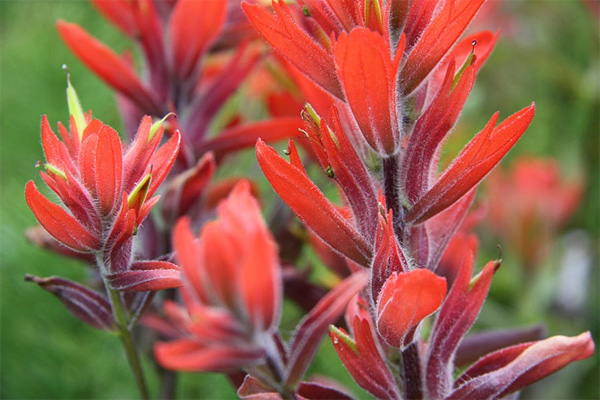
Tips and advice from a world caliber skimo racer Peter Svätojánsky
To progress Canadian and American ski mountaineering racing further we have to learn from each other but more importantly from those that are doing it longer than us.
Since one of my good friends is a world class ski mountaineering racer I asked him to share some knowledge (via an interview) that would take us long time to gain or to confirm.
A bit of background info

What made me interested wasn’t that I had a friend participating in “not a main stream sport” because in Europe ski mountaineering racing has been quite popular for long time by then.
But what made me über interested and involved was his progression and a passion as a racer.
The racing goals that Peter achieved in ski mountaineering are truly impressive considering the background he was coming from. Born and raised in Slovakia, a non-Alp country without a single glacier and without rich snow falls, he was lucky to start skiing quite early thanks to his parents. But shooting for sporting international success requires all your being in this Eastern European state.
After couple of years of super committed approach and support from his parents Peter was able to progress to international level racer. Since then, here and there, he has been able to support his development further with a help of scarce but passionate sponsors. However, his racing activities are still mainly depended on his own financial efforts and his family’s support.
Fortunately, smart and hard training usually pays off if you stick around long enough. And linking a year after year of the most sport committed lifestyle I ever saw Peter progressed in the modern era of super competitive skimo racing further than many thought was possible.
Here is a summary of his biggest international achievements, besides countless national level wins:
- bronze medals from World and European Championships
- 3rd place and couple of top 5 finishes at Pierra Menta – the biggest race in skimo racing
- 1st place at Whistler’s High Range Classic in 2007
- 5th place at the super long marathon event at the Worlds in 2008
- and many more achievements that are highly respectable
Now the goods – Peter talks racing
Here, via couple of questions, I asked Peter to share his experience and provide us with some tips and advice that might help us progress our passion further than we ever thought was possible.
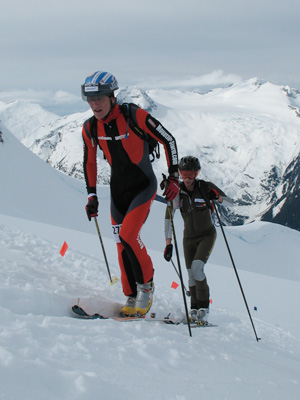
I competed in my first skimo race as 18-year old in 1995. Back then there were no junior categories, so I had to wait until I was legal to race. Before that I raced in cross country skiing.
My training was mostly dependent on what kind of race I was preparing for. But usually longer events suit me better thus my training was also geared more towards that.
Q: What do you think made you develop from a top national level racer to stand on some world’s prestigious podiums?
This was due to lots of experience I was able to gather at home events in Slovakia…and lots of commitment of course.
There were couple of racers in Slovakia back then that were quite competitive in the European Cup (now it’s called World Cup), therefore, I could compare against some high level racers.
Then once I was able to beat them at home I knew I could be ahead of them in the international races too. So this experience was what gave me a lot, including lots confidence.
Q: You are known to be able to prepare very well for your targeted goals. What are some of the things you watch for and do in training to be 100% when you need to be?
Everything is about a very committed approach. Over the years of racing I know myself very well, I learned what works for me. The only things that usually limit me are the time available to train and financial issues.
Q: What sports do you do in the summer? Which ones serve you well in preparing for ski mountaineering races?
I mostly ride my mountain bike or my road bike during the summer, and I also trail run a lot in the Tatra mountains.
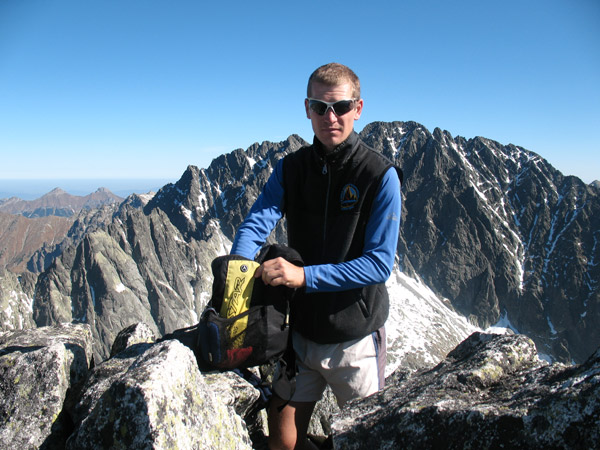
There were some high quality racers especially from places like Colorado, Montana and Wyoming. At other places, the racing form of ski mountaineering wasn’t developed much because people mostly prefer to do the sport without any competitive ambitions.
During the time when I was there everything was heading in the right direction, towards attracting more people into skimo racing. But what I missed was an involvement of young athletes. Of course, this is related to opening new categories for 15 to 18 year olds, which were non-existent back then. Are they now?
Simply any country that wants to have world class athletes in the future has to start working with the youth.
Q: Most of North America racers are about 30 years old which might be a little bit too late for starting to be competitive, but we all have good endurance base from long days in the mountains. What would you recommend to focus on primarily in training in order to get faster?
Of course, anyone who starts to compete in skimo racing after teenage years, and doesn’t have any experience with racing in this sport, won’t excel in speed. However, this speed can be trained quite well even latter but it requires lots of strong will and commitment to train systematically.
One of the best methods to train speed is to include a speed workout once a week in your program, year round. During the summer it is enough to include 10sec full-on sprints in one of your endurance workouts. Do around 6-8 of them separated by plenty of time of active rest (spin, jog).
Q: What do you think racers and organizers in developing skimo racing countries need to do in order to get to world class level in the future? How long it can take before even one NA is consistently in the top 15 of the biggest races?
As I mentioned before, it is all about committed and systematical work with the youth. The bigger the base pool the better the chance that someone will make it to the elite.
Personally, I think that North America can have as many talents as Europe has. You guys have very good predispositions – great terrain environment, could have great financial support and the culture, especially in US, makes you very ambitious.
The more races you will organize the more experience and skill can racers gain. Then the sport will gain more exposure and that will attract more sponsors.
I believe that North America can take this sport to another level if you guys will have quality racers since this will create more interest, therefore, giving it a higher level and a bigger chance to get included in the Olympic Games.
Q: For sure we are not the fastest but what strategy can we use at the upcoming world championships to have a bigger chance of higher placing in the standings? For example – start fast or slow, pace evenly…
It is a bit difficult to advise someone I don’t know. But in general, if a racer feels that he gave everything through an evenly paced performance he will have a better chance of success than somebody trying to run with the best from the start for as long as he can. Simply, he will be missing too much energy at the later stages.
Q: What is it like to compete in various European countries? For example compare some differences between competing in Slovakia, Italy and France.
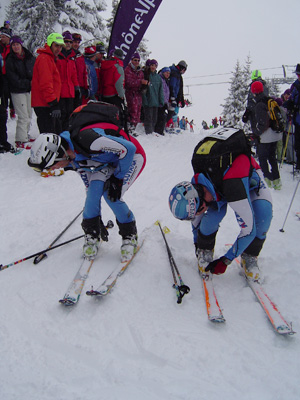
At Italian Cup races there is often as strong competition as at any World Cup event.
There are races that are way more prestigious than World Cup events or World Championships.
In France, Italy and Switzerland there are these three monuments – Pierra Menta, Trofeo Mezzalama and Patrouille des Glaciers.
Those events aren’t usually part of the World Cup circuit but popularity and attendance are over the roof.
Q: Who are currently the best skimo racers in the world right now?
The very best because they are the most consistent are Italians Manfred Reicheger, Denis Brunod and Guido Giacomelli. Then Swiss Florent Troillet, Spaniard Kilian Jornet and Frenchman Florent Perrier.
Q: At last some questions equipment. What skis and boots will you will be racing this season?
For ski boots Pierre Gignoux 500 and for skis most likely Ski Trab.
Q: You are 186cm tall, how long are your racing poles?
My racing poles are 138 cm long.
Q: What skins do you use for competition and why?
I use Colltex and Pomoca skins and I choose which one based on conditions.
Colltex skins usually glide better in a new wet snow and some times also on an absolutely frozen-through powder (frozen soft snow). Their disadvantage is that the glue is not as good as Pomocas have. I can put on Colltex skins for two maximally three climbs during a race.
Pomoca skins glue better to even a wet ski and you can use them for more climbs.
I usually test which skins I will use for a race the day before and I stick with that as the conditions usually don’t change too much over night.
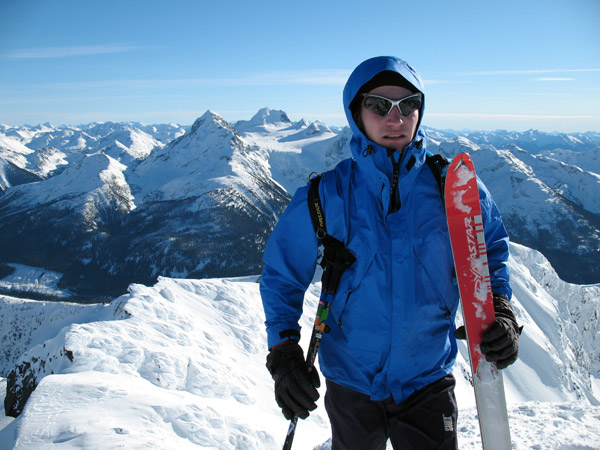
I don’t use the same equipment as there is no way I could afford that. I have a separate set for training because I am saving my best gear only for the biggest races.
I race my training equipment even at most of the races, only when I go to compete against the world’s best I pull out the carbon stuff.
So, my training skis are the same length and width but they are a bit heavier. Then for boots I use Scarpa F1 Race.
Saying hello
Peter says hello to everyone he met when he was here or during other occasions. And he is looking forward to see all NA racers in Europe this season.
On behalf of all readers I thank Peter very much for sharing such valuable information this openly.
All photos were taken by Stano Faban except the Pierra Menta transition one.
Interview with Julie Matteau – Canada's ski mountaineering champ enjoys every day in the mountains
A year ago, not many people involved with ski mountaineering and backcountry skiing knew Julie Matteau, except her touring friends and a couple of work related contacts. That is not the case anymore.
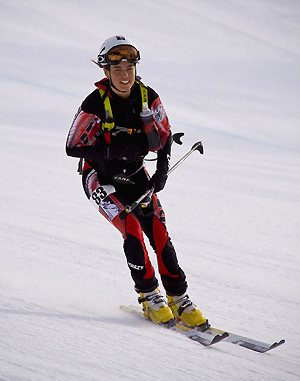
And while doing that, all of us that know or have met her, were treated to her happy smile all the time and everywhere.
Here is more from Julie in an interview about pretty much anything:
Q: Last season you won everything that Canadian skimo racing scene offers. Was that your goal or it just happened that way?
Last year, with a better pre-season training regime and a healthier body, I was definitely aiming to win as many races as I could.
My ability to focus and my level of skiing were much better which paid off. I was hoping, but didn’t expect, to win all the of the Canadian series races as well as I did.
Q: When did you start ski mountaineering racing and backcountry skiing? How did you start?
I started backcountry skiing back in 2001, the first winter after I moved to BC. It began as something I wanted to do as a recreational sport after being inspired from a friend’s pictures of Rogers Pass.
I slowly got into the sport, starting with renting the equipment and slowly getting my own. Only much later, in the year of 2007, was I made aware of the competitive side of backcountry skiing, ski rando racing, with the visit of European friends with their very light gear.
With a few friends/co-workers of mine at MEC, we all decided to race in Whistler at the Telus World Backcountry Freeride Jam Festival for the first time. Them with light equipment, and myself with my regular backcountry ski gear.
Despite the 2 days of hard racing, I truly enjoyed the course and the vibe within the crowd. I witnessed some serious speed by a few European racers that week-end, and it began.
Q: Is there anything that sucks being a gal when backcountry skiing and what are the benefits?
Being a gal doesn’t really suck, you can even get special treatment sometimes depending on your partners 🙂 On a more serious note, I have to say I’m very happy to have skied and ski with great partners that treat everyone with a lot of respect.
A lot of male friends appreciate us gals joining their group because it balances the testosterone level. I have heard it many times that “it’s good to mix it up”!
Q: You used to live in Vancouver (before in Quebec) but you moved to Revelstoke. Do you like it there?
I love it here! Not that I didn’t enjoy back east all those years or Vancouver in the last 8 years. The great living in Revelstoke for me, mainly involves living with my boyfriend and being able to enjoy what I love doing almost every day.
Revelstoke has an amazing outdoor “backyard” that offers limitless options if you like to be active. Its inspiring to live within a very fit and active community and it definitely responds to my love for the mountains.
Q: In Revelstoke, you get to ski with an amazing group. Besides being great people, they are also very strong skiers. What does a day trip with them involve?
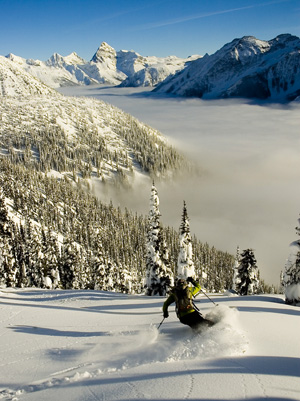
Their knowledge of the area and their abilities motivate me to be a better “mountain man”. Their fitness and skiing skills push my athletic abilities and allow me to improve on every level.
People I ski with are very efficient: start early, discuss our options for the day and its conditions, take only small breaks during the day to snack and have lunch and pound as much vert as the day allows us.
Everybody pitches in for setting the track and its amazing how efficient big groups can be around here…one day a group of 12 of us skied 9,000 feet in a regular day, everybody knew how to move.
Q: How much vertical feet/metres have you climbed the most in a day?
11,500 feet in one day. It was a long day with some big objectives….came back with our head lamps in the dark, such a good day!
Q: Do you do any specific training for skimo races or you just ski as much as you can, then go race?
Last year I built up my strength from May to January with Crossfit training in Vancouver, at Crossfit Westside with the amazing Jenika. I was lucky not to be working last year from January on, so I spent almost every day skiing. I had an extraordinary winter.
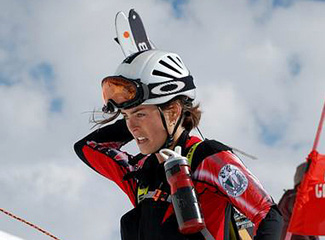
I did a few sessions of interval training as well which I think helped a lot. Racing is such a different mindset and requires a lot physically which is why I think you need to do both.
Q: Do you currently have any sponsors?
In the past I have been well supported by my ex-employer MEC but as of right now I’m on my own. I hope to get some sponsorship this year with the World Championships in Andorra and the Pierra Menta all coming up in 2010.
Q: What are your favorite activities beside ski touring?
I much enjoy mountain biking, trail running, climbing and Crossfit training. This summer I got to do a little bit more sport climbing and light mountaineering which I find very interesting. I’d like to improve my skills in these various sports to be a more well-rounded mountain athlete.
Q: What are your racing goals for the 2010 season? And what are your non racing goals?
My non racing goals always include staying healthy and enjoying every day I spend outside in the mountains!! I also want to improve my skills in less than perfect conditions, and my steep and rocky skiing abilities.
As for racing, I’m aiming to keep my title and continue to push my fitness. I’m shooting for a good result in the World Championships in Andorra and completing the Pierra Menta race.
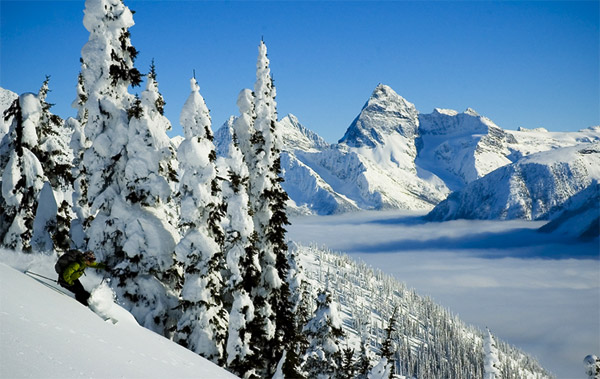
I like both depending on the individual. I’ve been skiing with guys the majority of my time since they outnumber us. There are few females that I would love to ski more with but I also enjoy the mixed group.
Q: Your boyfriend is also Canada’s top skimo racer (You are both on the Canadian National team). Do you think about how his race is going when you are racing, or you are totally focused only on your own race?
I always look up to the leading pack in a race and since Jeff [Ed. Jeff Colvin] is always in front of me I often wish he’s having a good race. Races are usually pretty long so it gives me lots of time to think. I definitely think of him while I’m racing but with very short thoughts.
I bring my focus back when I think of anything else other than the actual race I’m in. Everything happens so fast in racing that you want to be focused to minimize your errors.
I very much enjoy crossing either my boyfriend and my ski partner Andrew McNab when I race, its a huge motivation to hear them yell your name!
Q: How does your favourite day in the mountains look like?
My favorite day in the mountains is filled with friends, laughter, good snow, peeking from the sun and some amazing turns.
I like it when you don’t necessarily think the snow conditions are going to be perfect, but on your first turns you start getting little fuzzy feelings and you instantly get a permanent grin on your face 🙂
The non credited photo (the first one) in this article is from Julie Matteau’s collection. Author can contact me at “info(at sign here)skintrack.com” to add his name.
Interview with Andrew McLean – Icon of North American ski mountaineering
Andrew McLean is one of the icons of North American ski mountaineering, however, I didn’t know this until I met him couple of years ago at a ski mountaineering race. He won the event, and I believe it was the first time I got to see the Scarpa F1s racing boots in person, he wore them. Right the next day I researched him online and found him very interesting.
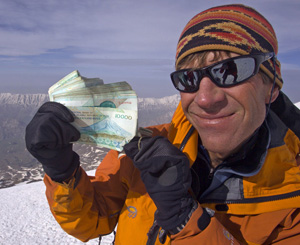
Andrew specializes in steep skiing in remote locations and has first descents on all continents to his credit. Some of the more exotic places he has skied at include Baffin Island, Antarctica, Iran and Morocco. Andrew’s current stomping grounds are Wasatch Mountains in Utah. You can following him through his blog at StraightChuter.com.
And here is more from Andrew in an interview about his relationship with ski mountaineering:
Q: How and when did you become involved in backcountry skiing and ski mountaineering?
I grew up skiing all the time as my mom was a ski instructor. This eventually led to racing and I was very involved with the junior program at our local hill, Alpental, which is about an hour outside of Seattle, WA. Alpental has a lot of steep terrain and easy access backcountry, so that kind of became “normal” skiing for me – steep slopes with funky conditions.
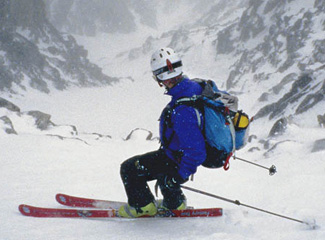 After High School, a friend turned me onto rock climbing and I spent a lot of my summers doing that, then when it snowed I went to the resorts.
After High School, a friend turned me onto rock climbing and I spent a lot of my summers doing that, then when it snowed I went to the resorts.
Years later, when I started working at Black Diamond Equipment, I met Alex Lowe and he turned me on to the idea of combining the two sports. I had always thought backcountry skiing was more like shuffling around on the flats, but Alex opened my eyes to the idea that you could find and ski way burlier stuff in the backcountry than you could ever find at a resort.
For the first few years I still did some resort skiing, but after I got my backcountry systems figured out, I started doing more and more of it, to the point that that is all I do nowadays.
Q: What keeps you still going strong from one adventure to another, what’s your motivation? And what do you like the most about backcountry skiing?
As far as adventures or expeditions go, skiing is a great way to visit new places, meet people and see different cultures. I love the aspect of going somewhere new and taking a chance on the skiing – a lot of times it is so-so, but when you find some killer new spot, it’s like hitting the jackpot.
I’m also into the idea of skiing projects, like going to all seven continents, skiing ten classics on ten consecutive days, skiing a group of three related peaks, etc.. It is like having bunches of little collections.
I think, the thing I like most about backcountry skiing is that it is a complex sport with so many different aspects to it, like skinning, route finding, avalanche safety, pacing, knowing when/where to go and the actual skiing itself. I first got into it just for the skiing, but now I really enjoy the entire package.
Q: You are a father now. (How) did that change your approach to skiing? Are you more careful?
I’d say I’m more careful now, not so much because I’m a father but more because I’ve seen so many talented and careful people have accidents or die while skiing. I’m also focusing more on skiing in cool places nowadays instead of just trying to find the steepest possible line.
As much as I love steep skiing, it takes perfect conditions to ski really steep slopes and you can burn up a lot of time, effort and energy by traveling around and hoping to hit it.
Another factor that comes from experience is that I think I am more selective about what and when I ski things now. If it seems like there is a chance a slope could avalanche, I’m more likely to pass it up knowing that I’ve skied tons of killer powder in the past and that this is not really a once-in-a-lifetime run.
Q: You have recently skied a first decent on Mount Foraker in Alaska. How does this adventure rate among your others?

Q: How many sleeping mats/pads does one need to get a good sleep in base camps of Alaskan giants like Foraker. Hunter or Denali?
I learned the hard, cold way that it takes more than one! On our first trip to Denali, I only brought one foam pad and it was a fairly miserable experience. I currently bring two pads (one inflatable and one foam). On our last trip I used an ExPed Down Mat pad which was enough by itself as it is super thick.
Q: What is your next ski mountaineering project going be?
I’m heading down to Antarctica in November as part of Doug Stoup’s Ice Axe ski cruise. The plan is to take a cruise ship across the Drake Passage, then use it as a floating base camp to take skiing day trips out on the Antarctic peninsula. It should be fun.
Q: Who or who’s ski mountaineering projects/activities currently inspire you, or you find interesting?
I’m inspired by all aspects of skiing and love watching free-skiers rip big lines, people huck monster cliffs and reading about the amazing speed of the Euro Rando racers.
Currently, when it comes to ski mountaineering inspiration, I like the idea of mixed media where you are exploring an area mainly on skis, but perhaps adding in some kiting or PackRafting. In that regard, I think some of the trips that Joe Stock from Alaska is doing are very cool as they are remote and exploratory, but still have some good skiing in them.
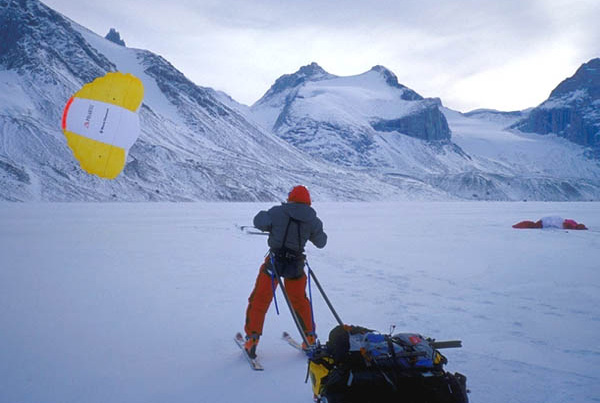
Q: In the past, you were involved in gear and equipment engineering design. Are you doing that these days too?
I’m still a designer by profession, although my skiing has gotten in the way of it. Due to my trips and new family, I’ve been working on lots of smaller projects rather than the multi-month or year long ones.
Q: Did you take part in any ski movies in your ski mountaineering career/life?
I’ve been in a few including most recently, “Steep.” Ski mountaineering is not very camera friendly as you have to haul lots of gear into the backcountry and the weather seldom cooperates. On top of that, I like skiing steep lines in remote places, which means I tend to ski very conservatively, which is exciting to do, but not necessarily watch.
Q: What do you do immediately after returning from a big trip?
When it comes to trips, I’m an organizational freak. I start packing days ahead of time, sort gear, check everything out, etc.. I also like to leave the house completely cleaned up so that when I come back, I can just dump out all the gear, clean it off and put it back. It usually takes me 2-3 days to catch up on email and phone stuff, as well as hanging out with the dogs and kids.
Q: When planning a trip/expedition, what are the most important things to do to increase the chances of achieving the objective?
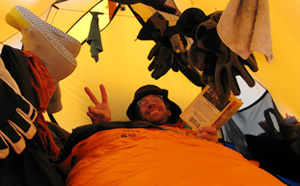
In that regard, I do a lot of careful planning. Probably the #1 thing I’ve learned is to allow plenty of time for a skiing trip as the weather and travel snafus can cut into a tight schedule.
If everything works out perfectly right from the start, then you just have some bonus ski time!
All photos in this article are from Andrew McLean’s photo collection and were taken by Andrew or his fellow trip companions.

